

Mage Knight - An Introduction
While our primary focus at RTM is on toys, there are also a variety of related fields that form part of the toy subculture. Along with toys themselves are the other items that are usually sold at the same specialty shops where many collectors frequent - comics, busts and statues, trading cards and role-playing games. With the introduction of the HeroClix game in May 2002, WizKids is straddling the fence between gaming and comics by making a set full of Marvel Heroes (and later in the year DC Comics characters), and this has drawn considerable interest from various comics and toy related media. The genesis of the game comes from WizKids 'Mage Knight' game, and this is an overview of the genre and the game to help introduce people to the concept and conventions.
 Mage Knight is the first game of a new genre dubbed a 'collectable miniature game' (CMG), and the one line description would be a cross between a collectable card game (CCG) and miniature wargaming, or Magic: The Gathering meets Warhammer. Each player assembles an army from pieces that are purchased in various ways (which are covered later in the article) and they battle until one side is left. Mage Knight is the first game of a new genre dubbed a 'collectable miniature game' (CMG), and the one line description would be a cross between a collectable card game (CCG) and miniature wargaming, or Magic: The Gathering meets Warhammer. Each player assembles an army from pieces that are purchased in various ways (which are covered later in the article) and they battle until one side is left.
 CCG's and CMG's combine gameplay and collectables in one package that can often appeal both to gamers and people interested in one genre or another. With CCG's such as Magic: The Gathering people collect various cards, which have ratings and descriptions that aid in using the cards during the game. Part of the collecting aspect of the cards is the artwork that is on each card. CMG's use small figures attached to bases (most around 1" tall) to appeal to collectors, but the base is what has the information for the gamer. CCG's and CMG's combine gameplay and collectables in one package that can often appeal both to gamers and people interested in one genre or another. With CCG's such as Magic: The Gathering people collect various cards, which have ratings and descriptions that aid in using the cards during the game. Part of the collecting aspect of the cards is the artwork that is on each card. CMG's use small figures attached to bases (most around 1" tall) to appeal to collectors, but the base is what has the information for the gamer.
One of the great advantages of CCG's and CMG's is that the play is very open-ended and the players usually have to rely on strategy and creative thinking to defeat each other. This differs greatly from many board games where there is usually a simple, linear path to the goal and it's more a matter of players working their way around to reach it. All the pieces are all fully painted and they are all made of plastic.
Playing The Game
Each player chooses a number of pieces to build his army based on the total point value for the game, and each piece has an individual point value to aid in balancing the game. The number of pieces isn't fixed, but based on the value of the pieces so players have flexibility in designing armies that suit their particular play style and that of their opponent. Each piece is part of a group (there are seven factions) that defines some of the characteristics of that piece, and different groups all have different advantages and disadvantages.
From there, the players then arrange their pieces on the field (which can be an elaborate miniature landscape or simply a table) and then start. They can each move a piece in turn, based on movement rates that are printed on the combat dial for that piece, and eventually combat (either direct melee or ranged combat) will ensue, with pieces dealing and taking damage as the game progresses. Dice are used to help resolve combat, but they are the familiar six-sided dice used in board games and casinos the world over. Eventually, there will only be pieces left from one player, who is be the winner.
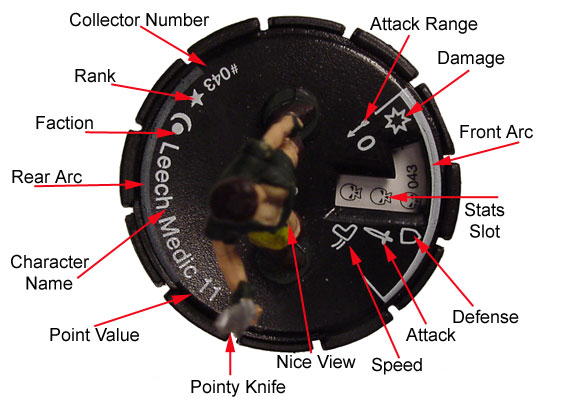
Many wargames are not easily accessible due to complex rules, tables and charts, but Mage Knight avoids much of the complexity by using the 'combat dial'. The dial is the base upon which the figure is glued and it contains all the important numbers for a piece (attack and defense ratings, movement, speed and damage). During combat when damage is taken the base is rotated changing the numbers that are displayed, eliminating the need for any tables or charts and automating the record keeping for the player.
How the Pieces Are Sold
Mage Knight (and other CMG's like Heroclix) are sold in several different packages to suit the needs of the gamer and that follow the same pattern as CCG's. Each line has a 'starter set' that includes extra pieces and the rules for that particular game or expansion set. Included with Mage Knight are also some mini comic books that help immerse the player into the world and concepts of Mage Knight. Beyond the starters are 'booster packs' which just have randomly inserted pieces for the game, similar to the way sports cards are distributed.
Players will usually only need one starter set to get the rules, then they can supplement their pieces through the expansions, boosters and by trading with other players. The starter sets have a suggested retail price of about $20 and the boosters are around $6-8. There are also a variety of special pieces (often much larger than the regular pieces) that may sell for $20 or more, depending on the piece.
The Games Available Now
There are several editions of Mage Knight, and the game started with the 'Rebellion' series. 'Rebellion' set the stage for the overall game, and established the various groups that are fighting each other and their general characteristics. The rebellions series consists of 160 different characters from 64 different sculptures. 48 of these sculptures come in three strengths while the other 16 are all unique pieces. The starter set for 'Rebellion' had 10 figures while the boosters had 5 each. This version is no longer in production but may still be available at your local collectables shop and some chain stores like EB.
The first expansion to the Mage Knight game was the 'Lancers' set launched in May 2001. 'Lancers' introduced mounted troops to the game, and also added pieces that used some of the 'special abilities' that were included with the 'Rebellion' rules. 'Lancers' added 142 characters to Mage Knight, included mounted troops. These are sold only in booster packs that have 4 random figures (1 mounted and three others), and all the figures are completely compatible with all the prior Mage Knight figures and rules.
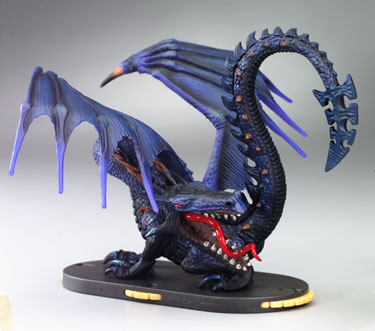
Venomous Shadow Dragon
To give players more powerful and larger pieces for the game, dragons and some other larger pieces were introduced starting in June 2001. The larger pieces have more complex combat dials (for various parts of the huge creatures) and are sold separately. The first was the Great Fire Dragon released in June 2001, followed by the Black Powder Rebel Chariot in July. The chariot can also be used to carry other pieces, giving them some movement and attack advantages. A Venomous Shadow Dragon was released in August 2001 along with the Atlantis Guild Chariot. This chariot can be used to ram other pieces in the game, adding a new ability. In October 2001 the Polar Ice Dragon (that could magically freeze other pieces) was released followed by the Black Powder Rebel Tank in November. The tank comes with special rules and was joined by another tank in December - the Atlantis Guild's 'Fist of Tezla'. The 'Fist' has five points of articulation and eight movable claws used to attack other pieces. The latest release in February 2002 is the Knights Immortal Charger, with chariot rules included. A Radiant Light Dragon is set for release in May 2002 to join the collection of larger figures, and all of these are compatible with the other Mage Knight figures and rules.
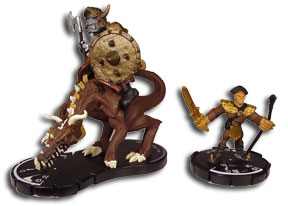
Mage Knight Whirlwind
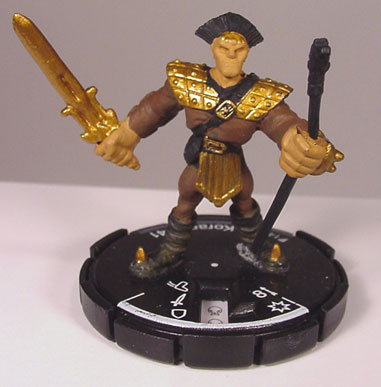
Mage Knight Whirlwind
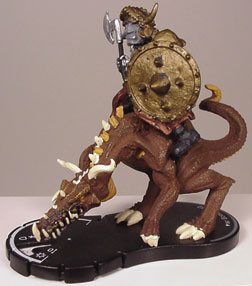
Mage Knight Whirlwind
While the various larger figures were being released, the second expansion for Mage Knight made its debut in October 2001. 'Whirlwind' introduced 142 more characters for the Mage Knight game, including more mounted figures. There were also some new special abilities and a new faction added in this expansion. These are only sold in booster sets with 4 figures (1 mounted, 3 regular), and are completely compatible with all the other Mage Knight pieces and rules.
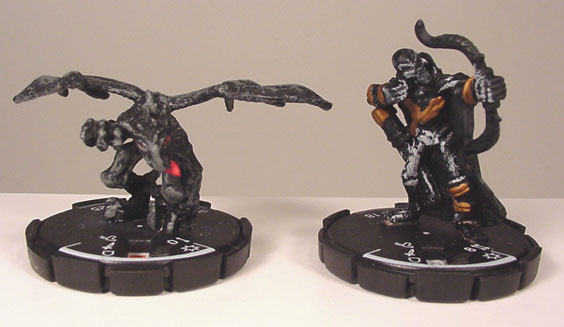
Dungeons
For 2002, a brand new game was introduced that still uses Mage Knight pieces, but adds in some of the trappings of role-playing games (RPG's) called 'Dungeons'. A new faction called 'heroes' was added which can be used to represent the player in the same way as characters do in RPG's. These can be used in regular Mage Knight games, but with 'Dungeons' there are some new rules and dungeon maps that the figures travel on. There are also treasure chests with allow the player to gain wealth and magic items. 'Dungeons' is sold in starter sets (with 2 heroes, 6 Mage Spawn figures and 2 chests) and boosters (with 1 hero, 3 Mage Spawn and 1 chest). There is also a 'Dungeon Builders Kit' that has new maps, as well as doors and terrain markers. There are two sets of artifacts that have been released, and these contain a variety of scale accessories to add to the dungeon maps such as tables, chairs and fountains. The 'Dungeons' game has 100 figures and 32 treasure chests.
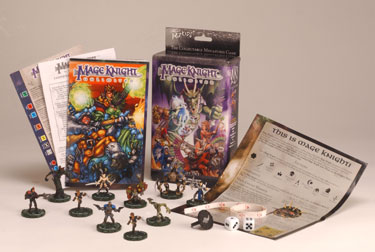
starter set - Mage Knight Unlimited
In March 2002 the Mage Knight introductory game was re-launched as Mage Knight Unlimited. The Unlimited game has the same rules as 'Rebellion' and the line is 160 figures strong. A mix of figures from 'Rebellion' and 'Lancers' are used for the figures in Unlimited, but there are 24 resculpts of classic pieces. There are also 16 new unique pieces to collect, and the bases of the Unlimited figures are molded in green (rather than the previous black) to differentiate them from other sets. Unlimited has both starter and booster packs with 10 and 5 pieces respectively. The boosters also have a 'Legends & Lore' card that explores the history of the game's universe.
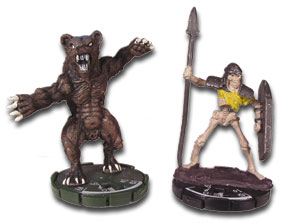
Unlimited (green base) vs. Rebellion (black base)
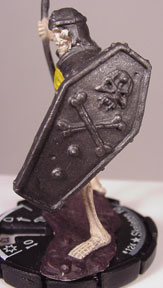
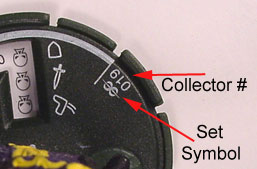
Mage Knight Unlimited
The first expansion for the Unlimited game is the 'Sinister' expansion set, that is designed to use the rules for Unlimited. 'Sinister' introduces two new types of figures - a new faction called the Solonavi, and the second group is a set of cross-faction figures that combine abilities that haven't been seen together. There are 100 figures planned for the set, and they are sold as boosters with 4 figures in each pack. There is a promotion with the 'Sinister�' set called the 'Four Horsemen' where the first person (18 and over) to get a set together of these ultra-rare figures will win a trip to Gencon 2002 courtesy of WizKids.
The Future of CMG's
The various incarnations of Mage Knight are the extent of miniature gaming currently, but the future is bright for the genre. In May of 2002 WizKids will introduce the Marvel HeroClix - Infinity Challenge starter set and boosters, with an expansion set to follow in October 2002. DC HeroClix - Hypertime starter set and boosters are scheduled for September 2002 release. In August 2002 the MechWarrior - Dark Age starter and booster sets will be released, with an expansion set due in November 2002.
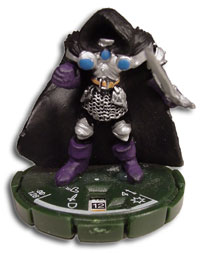
Along with the various new games that are being developed, Mage Knight continues to expand with the addition of more deluxe pieces and the castle expansion, which allows players to buy large pieces to build castles, battlements and other structures to spruce up their battlefields. The castle pieces have combat dials so damage can be tracked and they can even damage other pieces through collapse during a battle. The pieces will all be interchangeable and interlocking, to create unique castles and fortresses. These are due to be released in late April 2002.
There is a series of unpainted figures that will be offered that will allow the players to decorate their pieces in any way they'd like. Many people take great pleasure in painting their own figures, and this is one of the hallmarks of miniature gaming in decorating your own pieces. These are planned for release in July 2002.
Mage Knight Conquest is a system for resolving large-scale battles including siege equipment. This will be structured as the other games with a starter set and there will be some sets of siege equipment that can be purchased to add to the battles. This is set for release in June 2002 with the siege accessory set to follow in July.
The Collectable Miniatures
The figures in the various sets have different levels of rarity that determine how hard they may be to find. Pieces are ranked as 'weak', 'normal' or 'tough' varieties (shown by the number of stars on the figure's base), and the same figure is used with a different paint scheme to denote its relative power. There are also 'unique' figures, which are very hard to find and do not have ranking stars. The unique figures are made in much lower quantities and they are limited in their use in games (you may only have one of a unique piece on your side, unlike other pieces which may be duplicated).
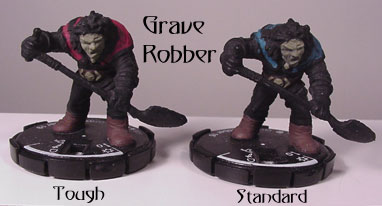
All the pieces are also numbered, with the number giving an idea of the general rarity of that piece. The lower the number, the more common the piece is to find, while the highest numbered pieces are the uniques. Each piece also has a point value to show its relative strength compared with other figures, and is used to balance an army by limiting each side to a predetermined number of total points.
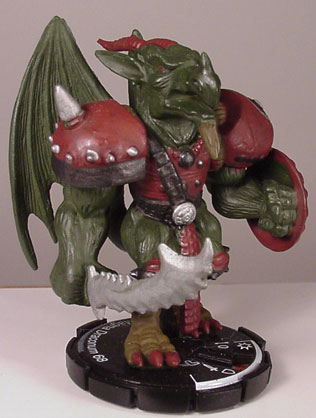
unique Magna Draconum
Mage Knight has strong roots in the toy industry, though it isn't apparent until a look beneath the surface. The initial manufacture of the line was aided by people at the now-defunct Resaurus Company, and WizKids shared showroom space with Resaurus at Toy Fair 2001. Early in the design of Mage Knight there was some freelance sculpting but now WizKids has taken most of that work in-house through Ral Partha who is owned by WizKids and has a long and illustrious history in miniature sculpture and manufacturing. There are many toy sculptors and design houses that have been (and continue to be) involved in working with Wiz Kids on Mage Knight and other CMG's, and we will continue to spotlight their work.
|









